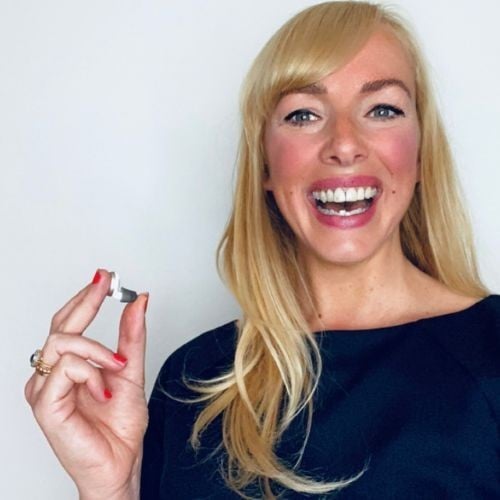
Head of Online Medical Content

Audiology Expert at Hearing Aid UK

What is High-Frequency Hearing Loss?
The causes, risks, symptoms and treatments
High-frequency hearing loss involves difficulty hearing sounds in the higher pitch range. It can result from ageing, noise exposure, or certain medical conditions. Symptoms may include trouble understanding speech, particularly in noisy environments. Treatment options often include hearing aids or assistive listening devices tailored to address high-frequency sounds.
In this article, we briefly talk about the main causes, risks, symptoms, and treatment of high-frequency hearing loss.
What type of hearing loss is high-frequency?
What is high-frequency hearing loss? High-frequency hearing loss refers to a type of hearing impairment where an individual has difficulty hearing sounds in the high-frequency range, typically above 2,000 Hz.
Although this type of hearing loss can be caused at any age, it is most common in older adults, those who are exposed to loud noises, certain medical conditions, and medications.
What are the symptoms of high-frequency hearing loss?
High-frequency hearing loss symptoms may include difficulty hearing high-pitched sounds, such as children's voices or birds singing, difficulty following conversations in noisy environments, and the need to increase the volume on electronic devices to hear them better. Even finding it challenging to hear certain consonants like s, h, or f can also be problematic.
High-frequency hearing loss causes
What causes high-frequency hearing loss? High-frequency hearing loss is common and can be caused by a number of different factors, including:
- Age (also called presbycusis): As we age, our hearing ability decreases, and we may start experiencing difficulty hearing high-frequency sounds.
- Noise exposure: Prolonged exposure to loud noises, such as concerts and construction sites, can damage the hair cells in the inner ear and lead to high-frequency hearing loss. Even a sporadic loud sound, such as an explosio,n can cause this type of hearing loss too. This is called sudden high-frequency hearing loss.
- Medical conditions: Certain medical conditions, such as otosclerosis, Meniere's disease, and autoimmune inner ear disease, can cause high-frequency hearing loss.
- Medications: Some medications, such as certain antibiotics and chemotherapy drugs, can cause temporary or permanent hearing loss, including high-frequency hearing loss.
- Genetics: Some types of high-frequency hearing loss can be inherited genetically.

Loss of High-Frequency Hearing
Is high-frequency hearing loss serious?
Diagnosing high-frequency loss and high-frequency hearing loss audiogram results
Diagnosis of high-frequency hearing loss is usually done through a hearing test, where an audiologist measures an individual's ability to hear different frequencies and decibel levels. If you have high-frequency hearing loss, the audiogram will show you have difficulty hearing frequencies between 2,000 and 8,000 Hz.
High-frequency hearing loss dangers and high-frequency hearing loss treatment
Can you fix high-frequency hearing loss? High-frequency loss cannot be reversed, but can be supported with hearing aids. These devices are the most common treatment for high-frequency loss, as they amplify high-frequency sounds and make them easier to hear. Other treatments can be:
- Cochlear implants: Cochlear implants bypass damaged parts of the ears and provide direct stimulation to the auditory nerve. These small electronic devices allow individuals with severe hearing loss, usually sensorineural, to hear sounds as direct signals and could help with either high-frequency or low-frequency sounds.
- Speech therapy: Speech therapy can help individuals with high-frequency hearing loss improve their communication skills and understand speech better.
Reducing the risks of high-frequency hearing loss
There are also preventative measures that can be taken to reduce the risk of developing high-frequency hearing loss, including wearing hearing protection in noisy environments, avoiding exposure to loud noises, and regularly having hearing tests.
So, what is low-frequency hearing loss?
Low-frequency hearing loss is a type of hearing loss where a person has difficulty hearing low-frequency sounds, such as the low-pitched sounds of speech and certain musical instruments.
This type of hearing loss can result from damage to the inner ear or nerve pathways that transmit sound to the brain, as well as exposure to loud noises, ageing, and certain medical conditions.
Symptoms of low-frequency hearing loss include difficulty hearing in noisy environments, trouble understanding speech, and the need to turn up the volume on televisions and other audio devices. Treatment options for low-frequency hearing loss include hearing aids, cochlear implants, and assistive listening devices.

In conclusion
It's important to seek treatment for high-frequency hearing loss as soon as possible, as any untreated hearing loss can lead to social isolation, depression, and difficulty with daily activities and communication. An early diagnosis also prevents further hearing loss and improves quality of life.
Why Choose Us?
- FREE Hearing Tests
- Best Hearing Aids and Prices
- FREE Aftercare for Life
- FREE Home Visits
- 200+ Local Audiologists
- 60 Day Money Back Guarantee
Looking at hearing aids for high-frequency hearing loss?
If you think you might have high-frequency hearing loss hearing aids are the main treatment for this type of hearing loss and others.
Call us free on 0800 567 7621 to find out more or to book a hearing consultation with an audiologist near you.
Read Next:
Other hearing loss awareness articles you might like...
 I have difficulty hearing in noisy places
I have difficulty hearing in noisy places  High-Pitched Sounds Like Birdsong Are Fading. Do I Have Hearing Loss?
High-Pitched Sounds Like Birdsong Are Fading. Do I Have Hearing Loss?  Asking people to repeat themselves frequently. Do I have hearing loss?
Asking people to repeat themselves frequently. Do I have hearing loss? What's included in our hearing aid prices?
Our specialist service includes:
Do not spend hundreds of pounds without getting a second opinion from us.
Please call us on 0800 567 7621
 Not only are the prices great, but the service is fantastic! Many thanks to your team.
Not only are the prices great, but the service is fantastic! Many thanks to your team.Other pages you might find useful
Common FAQs about hearing aids and hearing loss
If you are looking at this page then it is likely that an audiologist has suggested that you purchase this particular hearing aid, so is this the best model for you?
In general, any audiologist will always recommend to you the model that best suits your needs. Here is a useful checklist to make sure that is the case.
- Audiologist level of knowledge: The audiologist you have seen will hopefully have a wide knowledge of all available hearing aids, however, some will only be familiar with a small number of brands and therefore may not really be in a position to know which model is the best for you. It is OK to challenge their recommendation and ask them to justify why this particular brand is the one for you.
- Do research: Read about the hearing aid that was recommended. Does it seem like it will suit your lifestyle? Does it have more or fewer features than you need?
- Be aware of sales targets: Many high street retailers have specific tie-ins to a particular manufacturer/brand. The hearing aid they have suggested may still be the correct one for you, but do your research so that you know why they might have recommended it.
If in doubt, feel free to give us a call. That's what we're here for. In the meantime, read all about our review of the best hearing aids for 2025 here
If you have significant hearing loss in both ears, you should be wearing two hearing aids. Here are the audiological reasons why:
Localisation: The brain decodes information from both ears and compares and contrasts them. By analysing the minuscule time delays as well as the difference in the loudness of each sound reaching the ears, the person is able to accurately locate a sound source. Simply put, if you have better hearing on one side than the other, you can't accurately tell what direction sounds are coming from.
Less amplification is required: A phenomenon known as “binaural summation” means that the hearing aids can be set at a lower and more natural volume setting than if you wore only one hearing aid.
Head shadow effect: High frequencies, the part of your hearing that gives clarity and meaning to speech sounds, cannot bend around your head. Only low frequencies can. Therefore if someone is talking on your unaided side you are likely to hear that they are speaking, but be unable to tell what they have said.
Noise reduction: The brain has its own built-in noise reduction which is only really effective when it is receiving information from both ears. If only one ear is aided, even with the best hearing aid in the world, it will be difficult for you to hear in background noise as your brain is trying to retain all of the sounds (including background noise) rather than filtering it out.
Sound quality: We are designed to hear in stereo. Only hearing from one side sounds a lot less natural to us.
Fancy some further reading on this topic? You can read about why two hearing aids are better than one in our article, hearing aids for both ears, here
For most people, the main benefit of a rechargeable hearing aid is simple convenience. We are used to plugging in our phones and other devices overnight for them to charge up. Here are some other pros and cons:
For anybody with poor dexterity or issues with their fingers, having a rechargeable aid makes a huge difference as normal hearing aid batteries are quite small and some people find them fiddly to change.
One downside is that if you forget to charge your hearing aid, then it is a problem that can't be instantly fixed. For most a 30-minute charge will get you at least two or three hours of hearing, but if you are the type of person who is likely to forget to plug them in regularly then you're probably better off with standard batteries.
Rechargeable aids are also a little bit bigger and are only available in Behind the Ear models.
Finally, just like with a mobile phone, the amount of charge you get on day one is not going to be the same as you get a few years down the line. Be sure to ask what the policy is with the manufacturer warranty when it comes to replacing the battery.
Looking for more information on rechargeable hearing aids? Read our dedicated page on the topic here
For most people, the answer is yes. But it's never that simple.
The majority of hearing problems affect the high frequencies a lot more than the low ones. Therefore open fitting hearing aids sound a lot more natural and ones that block your ears up can make your own voice sound like you are talking with your head in a bucket. Therefore in-ear aids tend to be less natural.
However the true answer is we can't tell until we have had a look in your ears to assess the size of your ear canal, and until we have tested your hearing to see which frequencies are being affected.
People with wider ear canals tend to have more flexibility, also there are open fitting modular CIC hearing aids now that do not block your ears.
There is also the age old rule to consider, that a hearing aid will not help you if it's sat in the drawer gathering dust. If the only hearing aid you would be happy wearing is one that people can't see, then that's what you should get.
Most people can adapt to any type of hearing aid, as long as they know what to expect. Have an honest conversation with your audiologist as to what your needs are.
Generally speaking, six or more. Unless it's none at all.
The number of channels a hearing aid has is often a simplistic way an audiologist will use to explain why one hearing aid is better than another, but channels are complex and it is really not that straightforward. Here are some reasons why:
Hearing aids amplify sounds of different frequencies by different amounts. Most people have lost more high frequencies than low and therefore need more amplification in the high frequencies. The range of sounds you hear are split into frequency bands or channels and the hearing aids are set to provide the right amount of hearing at each frequency level.
Less than six channels and this cannot be done with much accuracy, so six is the magic number. However, a six channel aid is typically very basic with few other features and is suitable only for hearing a single speaker in a quiet room. The number of channels is not what you should be looking at, it's more the rest of the technology that comes with them.
As a final note, different manufacturers have different approaches. One method is not necessarily better than any other. For example, some manufacturers have as many as 64 channels in their top aids. Most tend to have between 17 and 20. One manufacturer has no channels at all.
Hearing aids are easily lost, misplaced or damaged and typically are one of the most expensive personal possessions an individual can own. We offer hearing aid warranty coverage for £80 per year per aid. Find out more about this service we provide here
All our audiologists use the very latest technology and provide the full range of tests to accurately measure your hearing for free. Find out about what hearing healthcare services we offer all our customers here
Hearing Aid UK offers all their customers free home visiting services, even in a care home environment, for no extra cost. Including hearing tests, fittings, maintenance, check-ups and much more in the comfort of your own home and at your convenience. Find out more information about our home visits here
Here, at Hearing Aid UK, we are dedicated to offering low hearing aid prices. We achieve this by having no head office and low marketing costs. Our hearing aid prices are amongst the lowest you will find anywhere in the world. Explore our prices, brands, and models here
Ask the Experts
6 Morton Lane
Walkwood
Redditch
Worcestershire
B97 5QA
Latest Launch
When we refer to a product as 'Latest Launch', we mean it is the latest to be released on the market.
New
When we refer to a product as 'New', we mean that the product is the newest hearing aid model on the market.
When we refer to a product as 'Superseded', we mean that there is a newer range available which replaces and improves on this product.
Older Model
When we refer to a product as an 'Older Model', we mean that it is has been superseded by at least two more recent hearing aid ranges.
